|
Thurs., March 1
11:00 a.m.
Academic Lecture Series -
1 West
Speaker: A. Kronfeld, Fermilab
Title: Course 5, Part 3: Lattice QCD with Applications to B Physics
1:00 p.m.
ALCPG ILC Physics and Detector Seminar -
West Wing- WH10
Speaker: Y.-K. Kim, Fermilab/University of Chicago
Title: Report from the HEPAP Meeting
2:30 p.m.
Theoretical Physics Seminar -
Curia II
Speaker: X. Garcia Tormo, Argonne National Laboratory
Title: What Can We Learn from Semi-Inclusive Radiative
Decays of Heavy Quarkonium?
3:30 p.m.
DIRECTOR'S COFFEE BREAK -
2nd Flr X-Over
THERE WILL BE NO ACCELERATOR PHYSICS AND TECHNOLOGY
SEMINAR TODAY
Fri., March 2
12:00 p.m.
Wellness Works Brown Bag Seminar -
1 West
Speaker: S. Brown, Wellness Consulting and Integrative Medicine
Title: Eat...Sleep...Breathe...& Move - The Small Changes You
Can Make for a Healthier You
3:30 p.m.
DIRECTOR'S COFFEE BREAK -
2nd Flr X-Over
4:00 p.m.
Joint Experimental-Theoretical Physics Seminar -
1 West
Speaker: I. Shipsey, Purdue University
Title: Latest Results from CLEO-C
Click here for NALCAL,
a weekly calendar with links to additional information. |
Thursday, March 1
-Santa Fe Black Bean
-Sloppy Joe
-Stuffed Peppers
-Sauteed Liver & Onions
-Baked Ham & Swiss on a Ciabatta Roll
-Assorted Slice Pizza
-Crispy Fried Chicken Ranch Salad
Wilson Hall Cafe Menu |
|
Thursday, March 1
Dinner
-Seafood Soup
-Grilled Duck Breast w/Pan Asian Flavors
-Brown Rice Medley
-Vegetable of the Season
-Ginger Shortcake with Strawberries
Wednesday, March 7
Lunch
-Trout w/Saffron Butter Sauce
-Winter Vegetable Medley
-Plum & Marzipan Tart
Chez Leon Menu
Call x4598 to make your reservation. |
|
|
CD experts switch roles
to educate students
This is the final story in a two-part series about computer security at Fermilab.
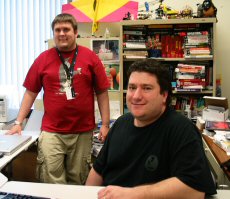
Tim Rupp and Joe Klemencic participated in Indiana's state-wide college cyber defense competition last weekend.
Two of Fermilab's computer security wizards traveled to Indiana Tech last weekend to participate in a very different kind of contest: a state-wide cyber computing defense competition. By portraying computer hackers, Fermilab's Joe Klemencic and Tim Rupp helped to educate the tech-savvy students about what motivates the enemy.
Sponsored by the National Science Foundation, the competition pits top students in computer science programs against would-be hackers to teach them about business security in a realistic environment. During the two days of the competition, the college teams completed business tasks sent to them by a White Team, representing managers, while fending off attacks from a Red Team, portraying hackers.
At Indiana Tech, teams from IT and Ivy Tech set up simulated business environments in classrooms networked through an internet connection. From another classroom, the Red Team, consisting of Klemencic, Rupp and the personal computers they'd lugged from home, tried to break into their computers. Because the teams focused most of their energy on preserving their computing infrastructure and resources, the Red Team successfully compromised their systems, said Klemencic. Unbeknownst to the students, they accessed the teams' web servers and personal data, such as usernames and passwords.
In a debriefing session on the final day of the competition, Klemencic and Rupp disclosed their strategies and tools to the surprised teams. "We had to drive into them that the bad guys aren't out to ruin their systems," said Rupp. "It's money that drives them. Systems can be replaced, but once data is lost, you can't get it back."
Rupp participated in the competition last year as a senior on IT's team. He did several summer internships at Fermilab before graduating and coming to work for CD in June 2006. Although his team lost the 2006 competition by only a fraction of a point, he's learned from Joe to keep on top of current hacker technology. "We talk all day long about new exploits that are coming," he said.
--Christine Buckley
|
40th Anniversary
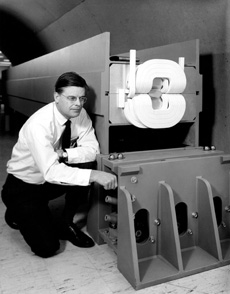
On this day in 1967, Robert Rathbun Wilson became the first director of Fermilab, known at the time as "NAL" (National Accelerator Laboratory). Twenty years later, for the lab's 1987 annual report, Wilson composed a "stream-of-conscious view" of starting Fermilab: "...my first months [were spent] in an unreal world in which I was the lone employee, wondering who, if anyone, would come to help me turn that cornfield into a physics laboratory. Eventually, brave physicists and engineers did come..." (more).
Throughout the year, FT will continue to provide milestones and stories about the lab's earliest days.
|
|
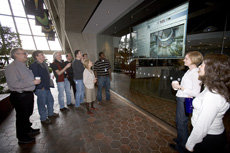
Going down: Employees gathered in the atrium yesterday to watch the online broadcast of the CMS magnet touchdown at CERN.
|
Worldwide Grids,
Worldwide Science

San Francisco hosted the 2007 meeting of the American Association for the Advancement of Science.
Scientists at last week's American Association for the Advancement of Science meeting discussed the use of grid technologies and volunteer computing to fight disease, predict earthquake effects and hazardous weather conditions, understand the origins of the universe, and decode our own behavior.
Read More
|
ABCNews.com
February 28, 2007:
Scientists Use 2,000 Ton Magnet to Study Matter
The world's leading center for research into the origins of matter on Wednesday took a giant step toward the launch of a 15-year experiment which scientists hope will unlock many secrets of the universe.
A huge magnet, weighing 1,920 tonnes or the equivalent of five jumbo jets and a key element in the program, was lowered into a vast cavern 100 meters below ground at the multinational center, CERN, on the Swiss-French border near Geneva.
Read More |
|
|
Not all top quarks
are created equal
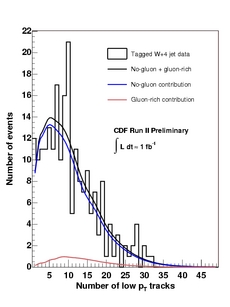
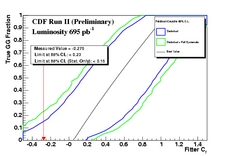
See descriptions below*
At the Tevatron, the proton and antiproton collisions are in actuality
collisions of the particles inside the proton and antiproton, quarks
and gluons. We expect that the top quark pairs we study are produced
by either colliding gluons (gg) or colliding quarks (qq), and we have
a prediction for the relative amount of each. Any deviation from the
Standard Model predictions of top production can point to the
existence of new physics such as supersymmetry. Has nature hidden
other top quark production mechanisms up its sleeve?
To the untrained eye, top quarks produced by gluons have very similar
characteristics to those produced by quarks. CDF distinguishes them
using two separate techniques. The first technique takes advantage of
the higher probability for a gluon to emit low-energy charged
particles than for a quark. On average, there are more charged
particles in gg collisions. Since there are large theoretical
uncertainties on exactly how much more, they calibrate the technique
in independent data with known gluon content. The second technique
uses the different kinematic characteristics of top quarks produced
from gg and qq to train an artificial neural network to distinguish
them.
Both techniques measure a gg fraction consistent with that expected
from the Standard Model, with measurement uncertainties that currently
exclude any anomalously created top quarks. But as more data is
collected, these results will put theoretical predictions to the test.
Now that top quarks are being produced so copiously at the Tevatron,
this is just the beginning of detailed studies of this most massive
particle.
Learn more about Techniques
1 and
2
*Upper graphic: The fit (black curve) to the low energy charged particle multiplicity distribution in ttbar candidates in data. The gg fraction (red) and qq fraction (blue) are shown. The background contribution was later on subtracted from the gg fraction.
Lower Graphic: The plot shows for simulated ttbar events the most probable region of gg fractions (Y axis) Vs a quantity obtained from the neural network (NN) output (X axis). The red line indicated the NN output obtained from data, and its intersection with the green band indicated the 68 percent confidence level limit.
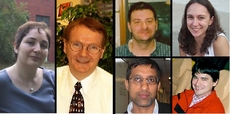
Above, from left: Shabnaz Pashapour and Pekka Sinervo, University of Toronto, worked on the charged particle analysis. From top left clockwise: Ricardo Eusebi, FNAL, Eva Halkiadakis, Jared Yamaoka and Sunil Somalwar, Rutgers, worked on the neural network analysis.
|
|
Open Science Grid Education Workshop
Deadline to register, March 2
The 2007 Midwest Grid Workshop will be held from March 24 to 25 at the National Center for Data Mining and the Laboratory for Advanced Computing at the University of Illinois at Chicago, and co-hosted at the International Center for Advanced Internet Research at Northwestern University.
The workshop introduces essential skills to conduct and support large-scale scientific analysis in emerging grid and distributed computing environments for researchers in many disciplines.
Participants will learn to use grids of thousands of processors and will be able to continue to use these resources for their research after the workshop.
Students, researchers, educators and professionals in any scientific, data or computing-intensive disciplines may apply.
The deadline is March 2 (notification by March 9).
For more information and application, please visit the web site.
Digital Certificates Training (No fee)
The Office for Professional and Organization Development is offering Digital Certificate training at no charge. Digital Certificates are commonly used at Fermilab and the broader open science community. When shopping online, the underlying technology that allows a transaction to remain secure is based on the use of digital certificates. Fermilab is now offering a beginning level course that will provide a background on certificates, then give specific instructions on how to install certificates in your browser, including the two most popular certificates at Fermilab: KCAs and DOEGrids. Internet Explorer, the Netscape family, and Safari will be addressed. You will have the opportunity to create your own digital certificate in the new hands-on portion of this class. You are welcome to bring your laptop to install your digital certificate, however it not necessary. This class is scheduled for March 12. To enroll, please visit this website.
Volunteer to teach Girl Scouts about other countries
A local Girl Scout Council is starting a program designed to teach
scouts about what it's like to live outside the U.S. They are looking for volunteers to
talk to the girls about what it was like to live in, or grow up in, another country.
If you are available from 12-2 p.m. on March 3, and would like to help out,
please contact Anne at Lucietto@fnal.gov.
English country dancing
English country dancing will meet at 2 p.m. this Sunday, March 4, at Kuhn Barn. Newcomers are most welcome and you don't need to come with a partner. The group will continue meeting the first Sunday afternoon of the month. For more information please contact folkdance@fnal.gov or call 630-584-0825 or 630-840-8194.
The hunt for dark matter workshop
There will be a symposium on dark matter, focusing on collider, detector and indirect searches from May 10 to 12 at Fermilab. The organizers are currently accepting abstracts for the event. You can register and submit an abstract here, or contact an organizing committee member with questions.
Upcoming Activities
|
|